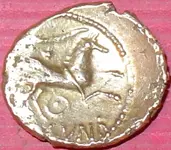CRUSADER
Emerald Member
This type of coin has been on the top of my wish list for 25 years or more. Now I have one.
It came from a pasture field which was hayed about a week ago. I have had no other Celtic items other than this off this field. Although we have noticed the soil is a good quality & less clay than the surrounding area.
This coin was most likely placed in the soil during a ritual to bless the land for good crops.
This coin was only 2inches deep (the field was ploughed about 10 years ago).
When I first dug it & I saw its edge, I thought 'wow a gold button!'. When I realised what it was & showed Dad there was much shouting & arm waving, so much so the farmer & his wife came out to have a look
Its a CELTIC GOLD STATER;
Ruler - CUNOBELIN
Minted about 20AD
Value - £500 ($1000)
To say I'm happy with this coin would be an understatement.
I am currently getting advice from the leading expert as it seems to be an unusual variant! (I will update later)
UPDATE (21/07/08)
This is what the Leading UK Expert said:
Congratulations! You must be delighted with this, and quite rightly so. I do like these wild type staters, partly because the horse looks so bizarre, and this is a good example of that.
As you say it’s VA 1933, of which there are 30 at
http://www.finds.org.uk/CCI/images-lister.php?&VA_type=1933.01
and another 45 at
http://www.finds.org.uk/CCI/images-lister.php?&VA_type=1933.03
I can’t remember offhand how VA separates these two varieties – something about the size of the little star on the reverse? I suspect this is not a very good way of separating them out, but no matter. I had a quick look for die-links, and there is at least one coin from the same pair of dies:
http://www.finds.org.uk/CCI/largeview.php?coin_num=97.1593
The obverse is quite recognizable because of the flaw on the second leaf up on the right, next to the M of CAMV. There’s another example of that obverse die here (which is listed as VA 1933.01, not 1933.03):
http://www.finds.org.uk/CCI/largeview.php?coin_num=67.0167
The reverse too is quite distinctive, with the ringed pellet very far over to the left below the horse. Again there may well be others from this die. In terms of date, Cunobelin’s wild type is usually placed somewhere in the middle of his reign, say c. 20 AD, so I guess your coin is coming up to its 2000th birthday!
THEREFORE ITS ONE OF ABOUT 76 RECORDED.
Quote from a leading dealer;
Retail; £550-600
He would buy for £400-450
Not that I would sell it, but I will give the farmer £200 to keep it.
It came from a pasture field which was hayed about a week ago. I have had no other Celtic items other than this off this field. Although we have noticed the soil is a good quality & less clay than the surrounding area.
This coin was most likely placed in the soil during a ritual to bless the land for good crops.
This coin was only 2inches deep (the field was ploughed about 10 years ago).
When I first dug it & I saw its edge, I thought 'wow a gold button!'. When I realised what it was & showed Dad there was much shouting & arm waving, so much so the farmer & his wife came out to have a look

Its a CELTIC GOLD STATER;
Ruler - CUNOBELIN
Minted about 20AD
Value - £500 ($1000)
To say I'm happy with this coin would be an understatement.
I am currently getting advice from the leading expert as it seems to be an unusual variant! (I will update later)
UPDATE (21/07/08)
This is what the Leading UK Expert said:
Congratulations! You must be delighted with this, and quite rightly so. I do like these wild type staters, partly because the horse looks so bizarre, and this is a good example of that.
As you say it’s VA 1933, of which there are 30 at
http://www.finds.org.uk/CCI/images-lister.php?&VA_type=1933.01
and another 45 at
http://www.finds.org.uk/CCI/images-lister.php?&VA_type=1933.03
I can’t remember offhand how VA separates these two varieties – something about the size of the little star on the reverse? I suspect this is not a very good way of separating them out, but no matter. I had a quick look for die-links, and there is at least one coin from the same pair of dies:
http://www.finds.org.uk/CCI/largeview.php?coin_num=97.1593
The obverse is quite recognizable because of the flaw on the second leaf up on the right, next to the M of CAMV. There’s another example of that obverse die here (which is listed as VA 1933.01, not 1933.03):
http://www.finds.org.uk/CCI/largeview.php?coin_num=67.0167
The reverse too is quite distinctive, with the ringed pellet very far over to the left below the horse. Again there may well be others from this die. In terms of date, Cunobelin’s wild type is usually placed somewhere in the middle of his reign, say c. 20 AD, so I guess your coin is coming up to its 2000th birthday!
THEREFORE ITS ONE OF ABOUT 76 RECORDED.
Quote from a leading dealer;
Retail; £550-600
He would buy for £400-450
Not that I would sell it, but I will give the farmer £200 to keep it.
Amazon Forum Fav 👍
Attachments
Upvote
21





 I almost posted my wheat cent find for today.
I almost posted my wheat cent find for today.

 He was thinking at the time I got the coin ' I will be happy with a nice button today & lets move to another field'
He was thinking at the time I got the coin ' I will be happy with a nice button today & lets move to another field'

 It's a beauty.
It's a beauty.  RR
RR

